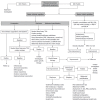Irritable bowel syndrome: a disease still searching for pathogenesis, diagnosis and therapy
- PMID: 25083055
- PMCID: PMC4112881
- DOI: 10.3748/wjg.v20.i27.8807
Irritable bowel syndrome: a disease still searching for pathogenesis, diagnosis and therapy
Abstract
Irritable bowel syndrome (IBS) is the most frequently diagnosed functional gastrointestinal disorder in primary and secondary care. It is characterised by abdominal discomfort, pain and changes in bowel habits that can have a serious impact on the patient's quality of life. The pathophysiology of IBS is not yet completely clear. Genetic, immune, environmental, inflammatory, neurological and psychological factors, in addition to visceral hypersensitivity, can all play an important role, one that most likely involves the complex interactions between the gut and the brain (gut-brain axis). The diagnosis of IBS can only be made on the basis of the symptoms of the Rome III criteria. Because the probability of organic disease in patients fulfilling the IBS criteria is very low, a careful medical history is critical and should pay particular attention to the possible comorbidities. Nevertheless, the severity of the patient's symptoms or concerns sometimes compels the physician to perform useless and/or expensive diagnostic tests, transforming IBS into a diagnosis of exclusion. The presence of alarming symptoms (fever, weight loss, rectal bleeding, significant changes in blood chemistry), the presence of palpable abdominal masses, any recent onset of symptoms in patient aged over 50 years, the presence of symptoms at night, and a familial history of celiac disease, colorectal cancer and/or inflammatory bowel diseases all warrant investigation. Treatment strategies are based on the nature and severity of the symptoms, the degree of functional impairment of the bowel habits, and the presence of psychosocial disorders. This review examines and discusses the pathophysiological aspects and the diagnostic and therapeutic approaches available for patients with symptoms possibly related to IBS, pointing out controversial issues and the strengths and weaknesses of the current knowledge.
Keywords: Diagnosis; Irritable bowel syndrome; Pathogenesis; Therapy.
Figures

References
-
- Bellini M, Tosetti C, Costa F, Biagi S, Stasi C, Del Punta A, Monicelli P, Mumolo MG, Ricchiuti A, Bruzzi P, et al. The general practitioner’s approach to irritable bowel syndrome: from intention to practice. Dig Liver Dis. 2005;37:934–939. - PubMed
-
- Videlock EJ, Chang L. Irritable bowel syndrome: current approach to symptoms, evaluation, and treatment. Gastroenterol Clin North Am. 2007;36:665–685, x. - PubMed
-
- Longstreth GF, Thompson WG, Chey WD, Houghton LA, Mearin F, Spiller RC. Functional bowel disorders. Gastroenterology. 2006;130:1480–1491. - PubMed
-
- Frissora CL, Koch KL. Symptom overlap and comorbidity of irritable bowel syndrome with other conditions. Curr Gastroenterol Rep. 2005;7:264–271. - PubMed
Publication types
MeSH terms
LinkOut - more resources
Full Text Sources
Other Literature Sources

